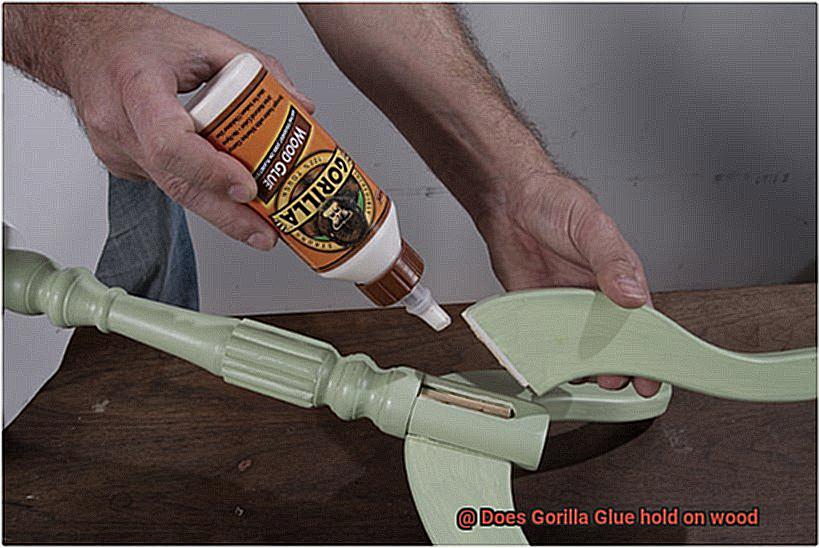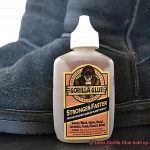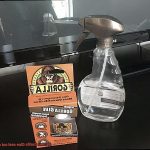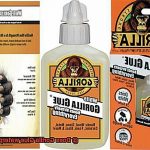Gorilla Glue has earned its reputation as a go-to adhesive for many DIY enthusiasts and crafters. But when it comes to woodworking, the question remains: can Gorilla Glue hold on wood? As someone who’s spent countless hours in the workshop, I’ve had my fair share of experiences with this popular glue. So, let’s get down to business – Does Gorilla Glue really work on wood?
The answer is a resounding yes. In fact, it can hold pretty darn well. However, before you start slathering it all over your wooden masterpiece, there are a few things you should know. For starters, Gorilla Glue is a polyurethane-based adhesive that reacts with moisture in the air and expands as it dries. This means it leaves behind a foamy residue that needs to be cleaned up after use. Additionally, it requires moisture to activate properly so if your wood is too dry, you may not get the desired bond.
But don’t let these minor details scare you off. When used correctly, Gorilla Glue is an effective adhesive for wood that creates strong and long-lasting bonds. In this post, we’ll take a closer look at how this glue works on wood and provide some tips for ensuring successful bonding. So grab your favorite beverage and let’s dive into the world of Gorilla Glue and woodworking.
What is Gorilla Glue?
Contents
- 1 What is Gorilla Glue?
- 2 Advantages of Using Gorilla Glue for Woodworking Projects
- 3 Disadvantages of Using Gorilla Glue for Woodworking Projects
- 4 How to Properly Prepare the Wood Surfaces Before Applying Gorilla Glue
- 5 Tips on How to Apply Gorilla Glue for Maximum Bonding Strength
- 6 The Different Types of Woods That Are Not Compatible with Gorilla Glue
- 7 Troubleshooting Common Issues When Working with Gorilla Glue
- 8 Conclusion
Gorilla Glue, a polyurethane-based adhesive introduced in 1994 by the Gorilla Glue Company, is known for its versatile and strong bonding capabilities. This moisture-curing formula creates a powerful bond between two surfaces, expanding and filling any gaps in the material upon exposure to moisture, making it waterproof and effective both indoors and outdoors.
One of the unique features of Gorilla Glue is its ability to bond different types of materials together, making it an ideal adhesive for various DIY projects and repairs. It works well with wood, metal, ceramic, foam, glass, and more. However, it isn’t recommended for use with polyethylene or polypropylene plastics.
When it comes to woodworking projects specifically, Gorilla Glue is one of the best types of adhesives to use. It bonds with wood fibers to create a strong and durable hold. But there are some things to keep in mind when using Gorilla Glue for woodworking projects.
Firstly, Gorilla Glue expands as it dries, so it’s essential to use it sparingly and apply pressure to the wood pieces being bonded together. Secondly, oily or dense woods such as cedar or teak may not bond well with the glue as it may not penetrate the wood fibers as effectively.
To ensure proper bonding, surfaces should be clean, dry, and free from any debris or dust. You can also lightly dampen the surfaces before applying the glue to activate the bonding process.
Advantages of Using Gorilla Glue for Woodworking Projects
This adhesive has numerous advantages that set it apart from other types of glue.
First and foremost, Gorilla Glue is known for its strong bonding capabilities. When you use this glue, you can be confident that your wood pieces will be securely bonded together for a long time. Say goodbye to worrying about loose or wobbly joints in your finished projects. This tight bond is especially important when creating furniture or other items that will be subject to frequent use and wear.
Another major advantage of Gorilla Glue is its water-resistant properties. This makes it an ideal choice for outdoor woodworking projects, where exposure to moisture is inevitable. Your finished project will remain strong and intact even in wet or damp conditions. This is especially important when creating items such as outdoor furniture, birdhouses, or garden structures.
In addition to its strong bonding capabilities and water-resistance, Gorilla Glue is also incredibly versatile. It can be used on a variety of different types of wood, including hardwoods and softwoods, as well as other materials such as metal, ceramic, and plastic. This means that you can use Gorilla Glue for a wide range of woodworking projects, making it a valuable addition to any DIY enthusiast’s toolkit.
But wait, there’s more. Gorilla Glue also has a relatively fast drying time compared to other types of adhesives. This means that you can get your woodworking projects done in less time than it would take with other glues. And as an added bonus, the glue expands as it dries, filling in any gaps or imperfections in the wood. This creates an even stronger bond between the wood pieces.
Disadvantages of Using Gorilla Glue for Woodworking Projects
Gorilla Glue has become quite popular in recent years, but before you grab that bottle, it’s important to understand its disadvantages.
Firstly, Gorilla Glue’s foaming properties can lead to messy and uneven results if not applied correctly. This expansion as it dries can also make it difficult to clean up any excess glue that may have spilled over onto your project. So, if you’re not careful during application, you may end up with a botched project.
Secondly, Gorilla Glue’s drying time is much longer than traditional wood glues like Titebond or Elmer’s Wood Glue. This can be frustrating for those who want to finish their project quickly or have time constraints. So, if you’re on a tight schedule, Gorilla Glue may not be the best option.
Thirdly, Gorilla Glue requires moisture to activate and bond properly. If the wood you’re using is particularly dry or if the humidity in the air is low, the glue may not bond as strongly as desired, leading to weaker joints and potential project failures. So, it’s essential to take this into consideration when using Gorilla Glue.
Lastly, Gorilla Glue is irreversible. Once it has bonded with the wood, it cannot be undone without damaging the wood itself. This means that if you make a mistake during the gluing process, you’ll have to start over completely. This can be frustrating and costly, especially if you’re working on an intricate project.
How to Properly Prepare the Wood Surfaces Before Applying Gorilla Glue
Properly preparing wood surfaces before applying Gorilla Glue is crucial to ensure a strong and long-lasting bond. Here are five sub-sections that explain how to prepare wood surfaces for Gorilla Glue.
Clean the Surface
The first step is to clean the wood surface thoroughly to remove any dirt, dust, or debris. This can be done using a soft cloth or brush. A clean surface will ensure that the glue adheres properly to the wood.
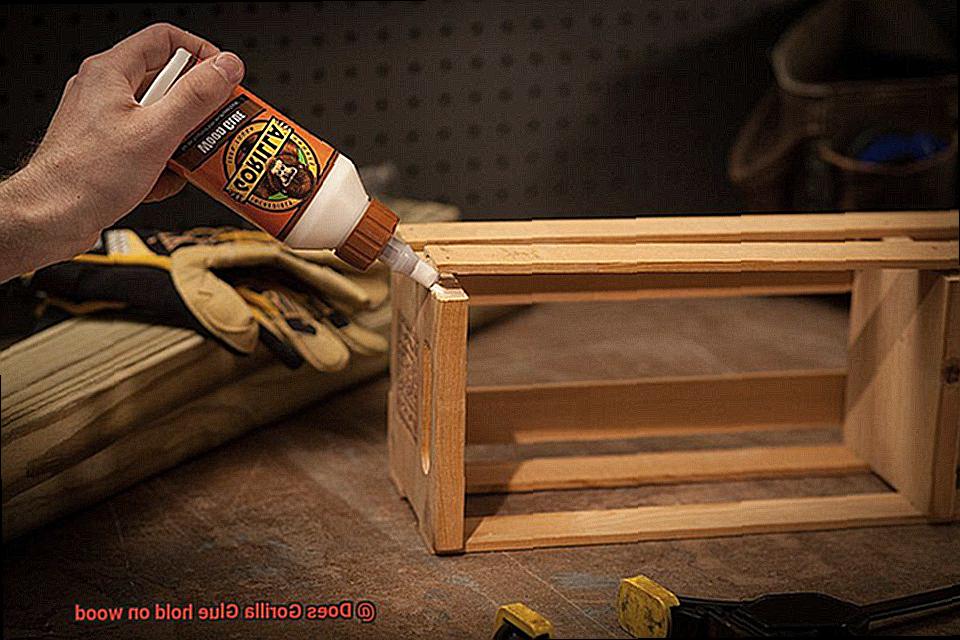
Sand the Surface
Next, sand the surface using fine-grit sandpaper. This helps to create a rough surface for the glue to adhere to, which can increase the strength of the bond. Sand in the direction of the wood grain to avoid damage to the wood fibers.
Remove Any Debris
After sanding, it’s essential to remove any sawdust or debris left behind. This can be done using a tack cloth or vacuuming with a soft brush attachment. Any remaining debris can compromise the strength of the adhesive bond.
Ensure Surface is Dry
Moisture can prevent Gorilla Glue from adhering properly. Therefore, ensure that the wood surfaces are dry before applying Gorilla Glue. Use a drying agent such as a fan or dehumidifier if necessary.
Test Before Applying
Finally, it’s important to apply a small amount of Gorilla Glue on a test piece of wood before applying it to your project. This will help ensure that you have properly prepared the surface and that the glue will adhere as expected.
Tips on How to Apply Gorilla Glue for Maximum Bonding Strength
Gorilla Glue is a versatile adhesive that can be used for woodworking projects, but to achieve maximum bonding strength, it’s important to follow a few key steps. Here are five sub-sections to help guide you through the process.
Clean and Dry Surfaces
The first step in using Gorilla Glue for maximum bonding strength is to make sure the surfaces being glued are clean and dry. Any dirt, dust, or moisture can weaken the bond between the glue and the wood. Use a clean cloth or brush to remove any debris and allow the surfaces to dry completely before applying the glue.
Apply Sparingly
Gorilla Glue expands as it dries, so applying too much can cause it to foam up and create a mess. To avoid this, use a small amount of glue and apply it quickly and evenly with a brush or applicator. Remember, a little goes a long way, and it’s better to apply multiple thin layers than one thick layer.
Press Together Quickly
Gorilla Glue sets fast, so you need to work quickly. Apply the glue to one surface and then press the two surfaces together within 10-15 seconds for maximum bonding strength. Use your hands or a clamp to hold the pieces in place while the glue dries.
Clamp or Hold in Place
To create an even stronger bond, use a clamp or heavy object to hold the pieces in place for at least an hour before removing them. This will help ensure that the glue has time to fully cure and create a strong bond between the two surfaces.
Rough Up Smooth Surfaces
If you are gluing two smooth surfaces together, it may be helpful to rough them up with sandpaper or a file beforehand to help the glue penetrate the surface. This will create more surface area for the glue to adhere to, resulting in a stronger bond.
The Different Types of Woods That Are Not Compatible with Gorilla Glue
When it comes to woodworking, the choice of glue is just as important as the choice of wood. Gorilla Glue is a widely used adhesive that boasts incredible strength and versatility. However, not all types of wood are compatible with this popular glue.
One of the main reasons why some woods do not work well with Gorilla Glue is due to their natural oils and resins. Woods like cedar, redwood, and teak contain high levels of natural oils that can interfere with the bonding process. These oils can prevent the glue from penetrating the surface of the wood and creating a strong bond.
Exotic woods like rosewood, cocobolo, and ebony should also be avoided when using Gorilla Glue. These woods are often used in high-end furniture and musical instruments where a strong bond is crucial. However, their high oil content can make it difficult for the glue to adhere properly.
Oak is another type of wood that may not be compatible with Gorilla Glue. Oak contains tannins that can react with the polyurethane in the glue and cause it to break down over time. This can lead to weakened bonds and eventual failure of the adhesive.
Additionally, some types of pressure-treated wood may not work well with Gorilla Glue. The chemicals used in pressure treatment can interfere with the bonding process, resulting in weak or failed bonds. If you are unsure whether your wood is pressure-treated or not, consult with a professional before using Gorilla Glue.
While Gorilla Glue is a strong adhesive that works well on most surfaces, it’s essential to choose the right glue for your specific woodworking project based on the type of wood you are using. By understanding which types of woods are not compatible with Gorilla Glue, you can ensure that your projects are successful and long-lasting.
Troubleshooting Common Issues When Working with Gorilla Glue
If you’re working with Gorilla Glue on wood, there are some common issues that can arise, but don’t let that discourage you. With a few troubleshooting steps, you can achieve strong and long-lasting bonds between your wood pieces.
Firstly, over-application of Gorilla Glue is one of the most common issues. Excess glue can squeeze out and create a messy appearance. To avoid this, use the glue sparingly and clamp the wood pieces together tightly. This will prevent excess squeeze-out and give you a cleaner finish.
Secondly, Gorilla Glue can take longer than expected to dry or cure properly. This is usually caused by applying too much glue or working in a humid environment. It’s important to follow the instructions on the label and work in a well-ventilated area with low humidity to ensure proper drying and curing.
Thirdly, some types of wood may not adhere well to Gorilla Glue due to their natural oils and resins. To improve adhesion, clean the surface thoroughly and roughen it up with sandpaper before applying the glue. You can also use a primer specifically designed for use with Gorilla Glue to help improve adhesion to difficult-to-bond surfaces.
Lastly, it’s important to note that Gorilla Glue expands as it cures, which can cause issues if not accounted for during application. Leave enough room for expansion and clamp the wood pieces together firmly but not too tightly. If excess glue does expand out of the joint, it can be sanded off once fully cured.
Also Read: Is Gorilla Super Glue Waterproof?
Conclusion
In summary, Gorilla Glue is a formidable adhesive that can successfully hold wood together. Its polyurethane-based formula reacts with moisture in the air and expands as it dries, resulting in a robust bond between two surfaces. Although Gorilla Glue has some limitations to keep in mind, such as its tendency to leave behind a foamy residue and its requirement for adequate moisture to activate properly, it still remains an effective choice for woodworking projects.
Despite its downsides, Gorilla Glue offers numerous benefits that make it an ideal option for various DIY projects and repairs. It can create a durable and long-lasting bond between different types of woods, including hardwoods and softwoods. Additionally, it is water-resistant and dries relatively quickly compared to other adhesives.
To achieve optimal bonding strength with Gorilla Glue on wood, proper surface preparation is key. It’s essential to clean and dry the surfaces before applying the glue sparingly while pressing them together quickly. Clamping or holding them in place also helps ensure successful bonding strength. However, some types of woods like cedar, redwood, teak, rosewood, cocobolo, ebony or oak may not work well with Gorilla Glue due to their natural oils or tannins.

